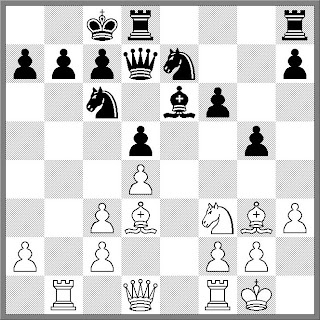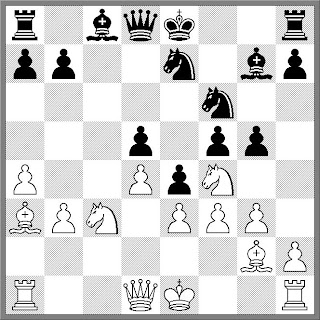

Alexander Alekhine's book of the New York 1927 international tournament is an acknowledged classic in European countries but is almost unknown in North America. The reason is simple: the book was published in German, and a proper translation has never been made available in English. Today we are going to remedy that situation to a small degree by presenting Alekhine's annotations to one of the more interesting games of the tournament: the first-round encounter between Frank Marshall and Aron Nimzowitsch.
Before this game, Marshall's lifetime score against Nimzowitsch stood at 2 wins, 3 losses, and 4 draws. He had won their last encounter (at Marienbad 1925) and was probably eager to level the scores, especially since he had the White pieces here. His choice of the Exchange Variation of the French Defence was a strange one for this purpose, although he gave it a typically aggressive interpretation. Nimzowitsch handled Marshall's attacking ideas in his own deeply positional style, and the result was an impressive victory, at least on the surface...
The commentary in standard font is by Alekhine from his book
Das New Yorker Schachturnier 1927, while the commentary in italics is by Nimzowitsch from his book
Chess Praxis. There are some interesting points of disagreement!
Marshall -- Nimzowitsch
New York 1927 (1)
French Defence C011.e4 e6 2.d4 d5 3.Nc3 Bb4 4.exd5 exd5 5.Nf3With this move White voluntarily gives up any pretensions to an opening advantage; moreover, by exchanging on c3 at a convenient moment, Black obtains chances of creating an enduring weakness in White's position in the form of doubled pawns. The immediate 5.Bd3 is therefore played more often.
5...Ne7 6.Bd3 Nbc6 7.h3 If 7.0-0 immediately, then 7...Bg4 would not be very pleasant for White. The asymmetrical development of the king's knights has not turned out in White's favour.
7...Be6 Nimzowitsch is emboldened by his opponent's unsuccessful handling of the opening and he therefore avoids the natural exchanging manoeuvre 7...Bf5 in favour of a plan that is complicated and interesting, but also not completely correct.
8.O-O Qd7 9.Bf4 Simpler was 9.Ne2 with approximately equal play. However, the move in the game is also not to be criticised – it actually gives good practical results because it provokes the opponent into some risky experimentation.
9...Bxc3 Over the past few years, play against weak doubled pawns has become one of Nimzowitsch's favourite strategic motifs; and he plays such positions, which he knows how to obtain in the most varied openings, with particular virtuosity. However, in the present case he is not on the right track because the insecure position of his own king is bound to interfere with the exploitation of his opponent's weak points. Of course, with the move 9...Bd6 he could have easily equalised the game.
10.bxc3 f6 In order to safeguard the bishop against a possible Nf3-g5 – the prophylactic meaning of 7...Be6 is thus clear. White now tried an attack on the open b-file, but it is not surprising that it failed, on account of the dynamic weakness of the double complex.A necessary consequence of his previous move. Because the king bishop has disappeared from the board, the dark squares must be defended as far as possible by pawns – but now the square e6 has been weakened.
11.Rb1 g5 12.Bg3 O-O-O (first diagram)Looks risky, but is part of the plan initiated on the 9th move.The king takes on the defence of the pawns on b7 and c7.
Generally speaking, the role of the king in defence has been seriously underestimated for a long time, particularly after the sad fiasco suffered by the efforts of the older Steinitz to use the king – with many other pieces still on the board – as an inducement for his opponents to attack. It is only the period since the Great War that has brought changes in this regard; see, for example, the games of the match in Buenos Aires, where even in the middlegame the kings often served to protect certain squares where a breakthrough was threatened; in other words, they played an active role well before the endgame.
Of course, Black's last few moves – by their directness and, in a certain sense, their strategic novelty – make a very favourable impression on anyone who believes in the evolution of chess strategy and its extension to new depths. Therefore it is almost vexatious to discover – after a very close examination of the position – that this plan is not only not the best, but that the correct response by the opponent – and not a difficult one to find at that – would actually put Black in a highly unenviable situation.
In view of all this it was better to forgo 11...g5 and play instead the more modest 11...Nd8 followed by 0-0, etc.
13.Qe2? Marshall's equilibrium has been disturbed by his opponent's boldness, and he commits – both here, and later on – a series of inaccuracies that are difficult to remedy. For example, instead of the queen move – which carries only the crude and easily-parried threat of 14.Ba6 – a less-stereotyped plan of attack was appropriate: 13.Nd2! If, say, 13...Nb8; then 14.Nb3 b6 15.Qe2 – this time with really unpleasant threats. It would therefore be better for Black to reply to 13.Nd2 with 13...Na5 with the aim of exchanging off the enemy knight on its way to c5. However, notwithstanding that this exchange would restore White's pawn position on the queenside and would therefore demonstrate the insufficiency of the plan begun by the move 9...Bxc3, White would in any case be under no obligation to play the immediate 14.Nb3; very strong instead would be Qd1-c1 (followed by Qc1-a3 when appropriate) and only then the move of the knight. It is not difficult to convince oneself that by adopting such a plan of play White would obtain an enduring initiative. Now, on the other hand, he gradually runs into difficulties.
13...Rde8!Not 13...Rdg8 because a flank attack is best undermined by a concentration in the centre and not by a counter-attack on a wing.Defence (by clearing the square d8 for the king) and counterattack at the same time.
14.Rfe1If 14.Ba6 then 14...bxa6 15.Qxa6+ Kd8 16.Rb7 Nf5! 17.Rxc7 Qxc7 18.Bxc7+ Kxc7 with an easy win.
14...Nf5 15.Bxf5(?)The move 15.Ba6 proves insufficient after 15...bxa6.It is only through the absence of this bishop that White's queenside pawns become really weak – and this promises White a difficult endgame. In spite of the obvious danger, more chances were offered by 15.Bh2.
15...Bxf5 16.Qb5 Nd8 17.Qc5?The decisive mistake, giving Black an opportunity to set up – with tempo – a solid defensive position on the queenside. By playing 17.Qa5! Marshall could have prevented this, since if 17...Kb8 then 18.c4! and the resulting complications are not unfavourable for White.
17...b6 18.Qa3 Kb7 19.Qb3The beginning of a tragedy: the square c2 can hardly be defended otherwise.
19...Nc6 Already a blockader makes for c4 where it will demonstrate the weakness of the doubled pawn.20.Nd2On the 13th move this would have been the start of a very promising attack, but now it is just a modest defence against the threat of a knight invasion on c4. The storm clouds are gathering.
20...Na5 21.Qb2 Rxe1+ 22.Rxe1 Re8 The double exchange of rooks is connected with a purely tactical idea (to say nothing of the fact that Black does not need these pieces in order to realise his advantage): Black eliminates the threat of Nb3-c5+ (after Nd2-b3) and at the same time he avoids the exchange of knights, which would otherwise be forced.
23.Rxe8 Qxe8 24.Qb1What else could White do? If 24.Kf1, for example, then 24...Qa4 would be very strong.
24...Kc8(?)Here 24...Qe2 was also good.Time pressure, obviously; otherwise one cannot understand why Black did not play 24...Qe2! Then after 25.Qc1 White would be practically stalemated, while in case of 25.Nb3 Nc4 26.Nc5+ Kc8 27.Nd3 Nd2! Black would win material and also retain the attack.
25.Qd1 Qe6 Also strong was 25...Qc6.
26.Nb3 Nc4 27.Nd2 Na3 28.Nf1 Nxc2 Now Black has an ending with a pawn plus but bishops of opposite colours, and many of the onlookers prognosticated a draw.Because of the presence of opposite-coloured bishops, White could perhaps reconcile himself to the loss of this pawn, if not for the structural weaknesses on his queenside. But now he can only wait while his opponent prepares the fatal blow.
29.Qh5 Bd3 30.Qd1 Qe4 Not 30...Qe2 at once because of 31.Qxe2 and 32.Ne3.31.Nd2 If 31.f3 then 31...Qe2 is sound.31...Qe2 32.Qxe2After 32.Qc1 Ne1! White would gradually perish from suffocation.
32...Bxe2 33.f4 Na3 34.fxg5 fxg5 35.Kf2Otherwise Black plays 35...Nb5 followed by Be2-d3, etc.
35...Bh5 36.Be5 g4 37.hxg4Black can only welcome pawn exchanges because on the other wing he has enough material for a win. Therefore from the practical point of view it was better to play 37.h4.
37...Bxg4 38.Ke3 Bf5 39.Bg7 (second diagram) 39...Be6!Threatening to win a pawn with 40...Nb5, which if played immediately would be premature on account of the possible reply c3-c4. White, being obviously in time pressure (the 40th move!) does not notice the threats, and after this the endgame does not present his opponent any difficulties whatsoever. However, Black would also win after 40.Kd3!, for example: 40...Kd7 41.Bf8 Bf5+ 42.Ke3 Nc2+ 43.Kf4 Bg6 44.Ke5 Ne3, etc.
40.Bf8? Nb5 41.Nb1 a5 Here 41...Bf5 was also playable: 42.a4 Bxb1 43.axb5 Ba2 44.Kf4 Bc4 45.Ke5 Kd7 46.Bb4 c6 47.bxc6+ Kxc6 and the king migrates to b3.Also possible was 41...Bf5, since if 42.a4 Bxb1 43.axb5, after which the simplest way for Black is Kc8-d7 followed by c7-c6 (in case of Ke3-f4-e5). After the exchange of pawns his king gets to c4.
42.Kd2 A winning line, not unlike that shown in the preceding note would be: 42.Kf4 Bf7 43.a4 Bg6 44.axb5 Bxb1 45.Ke5 Ba7 46.Ke6 Bc4 with 47...Kb7 and 48...c6, etc.42...Bf5 43.Na3 Nxa3 44.Bxa3 Bb1 45.Bf8 Bxa2Marshall could have quietly spared himself the following 15 moves.
46.Bg7 Bc4 47.Ke3 Kb7 48.Bf6 Ka6 49.Kd2 If 49.Bd8, Black has a win, the king penetrating to b3, e.g., 49.Bd8 Kb5 50.Bxc7 Kc4 51.Bxb6 a4, with 52...Kb3, and wins as the a-pawn cannot be stopped. This variation shows the enduring weakness of the dead and gone double complex. For in the passed a-pawn is mirrored the weakness of the defunct White a-pawn, and in the blocked long diagonal f6-a1 is manifested, in memoriam, the obstructive effect of the pawn formation c3 and d4. White might have resigned here.49...Bf1 50.g3 Kb5 51.Kc1 Kc4 52.Kb2 c5 53.Be5 cxd4 54.Bxd4 b5 55.Bb6 a4 56.Ba5 d4 57.cxd4 b4 58.Bb6 a3+ 59.Ka2 Kb5 60.Bc5 Ka4 White resigned. 0-1










